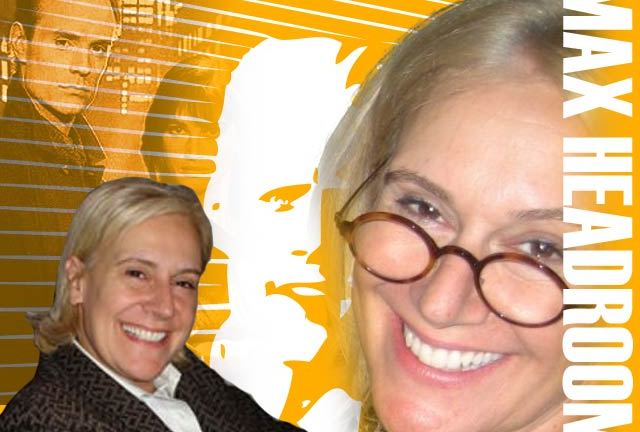Max Out: Annabel Jankel interview
Max Headroom co-creator Annabel Jankel talks us through the conceptualisation of the character...

Coming from a background that took in computer graphics, film-making, pop videos and commercials, Annabel Jankel fused her interests – along with partner Rocky Morton – into the synthetic, wisecracking and very subversive video-jockey Max Headroom in the mid-1980s.
Annabel kindly spared us a little time recently to explain the genesis of Max…
What was the moment that Max first sprang into existence? The casual viewer would guess that you were leaving a car park at the time….?
George Stone, our original writer and co-creator came up with the title in response to a request to Rocky Morton, George Stone and myself – for a TV series to be devised that would showcase existing music videos for the newly launched TV channel in the UK: Channel 4. The brief was to link music videos with graphic elements to segue between the music videos.
George Stone proposed the title, and Rocky Morton and I had an animation company called Cucumber Studios doing commercials, music videos, and titles. We had been experimenting with live action and embryonic computer graphics, and the title The Max Headroom Show was more about evoking a sense of limitless possibilities than about a character at that early stage of development.
Based on Bryce Lynch’s age in the Chrysalis pilot, we are now exactly twenty minutes into the future, as it were. Aside from the obvious technological anachronisms, was it a prophetic show?
Yes I believe it was somewhat prophetic, on certain levels – especially the CCTV now so evident everywhere – and to some extent mirrored the fears that we could only imagine, the worst and best of where technology was going. For example, when we wanted to research the early Internet at that time, it was largely only govt. Maps and weather on Prodigy, and hugely dull, so we could only speculate the potential. George Stone was a big Philip K. Dick aficionado and might say that if anyone was prophetic – it was Philip K. Dick.
In many ways it was in sync with other pieces of its time: Blade Runner and Brazil for example, which unbeknownst to us was filming on the next stage to where we were shooting Max Headroom, the film.
It was prophetic on a visual level, as Rocky Morton and I had a fascination with computer graphics, but obviously a fully computer generated character was yet to be fully realised – bar “user friendly” at Nyit, a huge source of inspiration – but we could see how animation would harness this technology and what it might look like, glitches and all, in the near future.
Blank Reg fighting for his life on a Courtroom TV game show must have seemed over the top back then – moreso than it does now?
This reference is presumably from the US TV series which we were not involved with, so I can’t really answer that, but certainly reality shows have seized the airtime.
Many people consider the 80s divided into two distinct sections – post punk/post 70s and then ‘yuppie’. Max Headroom caught the cynical mood of the second half of the 80s right as it started – was that a coincidence that surprised you?
I think that when you are “inside” the movement, you don’t really see what’s happening outside, or how it’s affecting the scene. Probably we were unconsciously generating and bouncing back a mood of post-punk, where experimentation was expected, and rewriting the rules to express yourself fully, was mandatory. So it wasn’t really surprising at that time, just very rewarding that something that we had been working on so intensely seemed to resonate. In hindsight, it’s surprising though!
You co-wrote a book on computer graphics before Max Headroom, and Max was a masterpiece of basic, textureless phong shading, from the look of it. Did you attempt to render the character before deciding on an actor?
We fully researched the potential to generate an actual CG head, by going to various academic and production facilities, but the state of the art was so unacceptably basic and uninteresting that we recognised that what was needed was a sleight of hand, to engage an audience. We had recently visited the US, and found it fascinating how the “talking head” dominated the airwaves, and so we elected to look for an actor that could provide the heart and soul of the character.
The approach we took was to combine all the techniques that we were familiar with: animation, live action, computer graphics, video editing, special fx, special visual effects, sound effects and so on, to create an amalgam that couldn’t be characterised as one specific thing and therefore function as a new creation.
How did Matt Frewer come to play the part?
He was a Canadian living in London, and we could only afford to cast in London – not North America. He was extraordinary in the casting, undeniably Max from the get-go, so he got the gig.
Were you honoured or alarmed when you heard of the real-life pirating incidents where a fake Max Headroom interrupted PBS and another American channel?
I personally didn’t hear about it until long after, and of course there was no YouTube in those days. I think it was impressive that there was the motivation and technical talent out there to shake things up. The beginnings of interactivity!
Max is a very naughty boy who doesn’t care what he says – was Frewer integral in forming that very irreverent character, or was it entirely scripted?
It was scripted as such. Max was conceived as an irreverent, politically-incorrect character, a contrarian and a narcissist, in conflict with his “alter ego” Edison Carter – the right-on investigative journalist, exposing the world’s ills. However, Matt Frewer brought everything and more to breathing life and wit into the character, with his stellar comic timing, and brilliant improvising.
Is it true that William Gibson was going to write for the show before it was cancelled?
I am not aware of that, though I am a huge admirer of his work.
Would the TV series itself have had more success if it had been made 10 years later, as many believe?
No, I believe that it wasn’t the timing of the show that led to it’s demise, but its fluffiness, reworked for a US audience, whereby Max was homogenised into something less provocative and thus less worth watching.
You have an extensive background in TV advertising, amongst many other facets – did you participate in bringing the Max character through his various TV incarnations, such as the New Coke ad, the chat-show and the American re-boot of the UK pilot and subsequent series?
Rocky Morton, George Stone and I created the original character, the bible, and made the first UK TV film – the original story; and the 13 part TV-series that followed – all for the UK’s Channel 4. We were not involved in the New Coke spots or the subsequent US TV film or TV series.
Is Max coming back? The recent digital TV ads on ITV caused a great deal of interest on the internet.
In that case, I guess he did come back…
What can you tell us about your new film Skellig?
Skellig is from the award winning young adult novel of the same name by David Almond, about a character that also goes through a transformation. But that’s another story….
Annabel Jankel, thank you very much!
Many thanks to George Cole for letting us use his images of Annabel Jankel. You can check out George’s own interview with her here.

